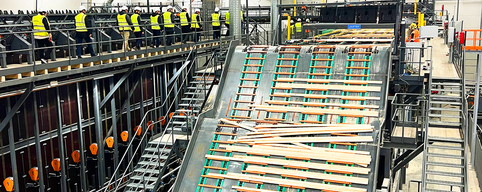

Following Russia's invasion of Ukraine, sanctions were imposed that included a complete ban on Russian timber imports into the EU and other Western countries. The ban has caused a shortage of timber throughout Europe, and Finland has been one of the countries most affected by this conflict.
According to Wood Central, Finland imported approximately 7-10% of the raw wood used in its processing industry from Russia before the invasion of Ukraine. In southeastern Finland, the reliance on Russian wood by mills was even higher.
Companies such as Stora Enso and Metsa Wood heavily depended on the Russian market for their feedstock. Stora Enso's decision to close its Sunila pulp mill in Kotka was directly related to the ban on importing raw Russian logs.
Dr Ali Harlin, a research professor at the VTT Technical Research Centre of Finland, has highlighted the emerging problem of wood availability across supply chains in Finland. According to Dr Harlin, this shortage can be attributed, in part, to the Russian import ban and the increasing use of wood chips and pallets for biofuel, which has led to mill shortages.
The Finnish forest industry is undergoing a significant transformation as the demand for materials rises. Dr Harlin stresses that the availability of wood as a raw material is becoming more challenging and limited.
Additionally, competition for wood is on the rise as carbon-intensive industries embrace biomass and biofuels to decarbonise their operations.
Unfortunately, increasing forest harvesting is problematic due to the carbon sink obligations set by the EU. According to Dr Harlin, the growth of forests has recently declined and is not expected to recover to its previous level.
Dr. Halin suggests that the solution to raw material shortages lies in increasing the value of the forest industry's end products. While increasing volume was a feasible approach in the past, it is no longer possible under the current model. Instead, more added value should be generated from the same amount of raw materials.
Dr. Halin points out that financial signals already indicate a shift in this direction. Investment in new product development has multiplied in the 2020s, signaling a positive trend. He remains optimistic that these projects will progress to the trial phase actively.
In a noteworthy development, Dr Halin highlights Lignin as a promising choice for fostering innovation and progress. Typically considered waste by the pulp and paper industries, Lignin comprises around 20 to 30% of the wood composite.
However, in Finland, the perspective is shifting, and there is now a desire to extract value from Lignin wherever possible.
Dr Halin reveals that Lignin is being utilized to create highly refined and valuable products, such as fine carbon powder specifically designed for lithium-ion batteries.
Stora Enso, despite closing its Sunila Mill, will continue to operate a pilot plant for its carbon product. This indicates that the company is still exploring possibilities for further development in this area.
Furthermore, Satu Härkönen, Stora Enso's head of communications, has stated that the company is actively seeking new applications for lignin.
"As an example, we have successfully developed lignin-based glue, which is fully bio-based. We have also conducted tests using lignin as a substitute for bitumen, such as in asphalt production."
According to Dr Harlin, there is great potential for Finnish companies in various sectors with "more than a dozen promising products" currently in development.
Some examples of these innovative products include new textile fibers made from cellulose, biocarbon-based materials like carbon fiber, and alternative packaging materials.
According to Wood Central, many companies are now in search of alternative materials to replace wood fibers. One such company is Fiber-X-Finland, which is currently testing new fiber sources for pulp production. CEO Mikko Ruuska states that there is a demand for testing, particularly from outside Finland. The global demand for products made from alternative materials, including waste or post-consumer products, is becoming increasingly evident.
International fast fashion giants are among those driving this demand, seeking to create clothes from waste materials. As a result, there is a growing market for waste fibers obtained from agricultural sources like straw and hemp. Rather than allowing this field waste to be burned, it can be repurposed to make pulp that can be used in various industries, including clothing manufacturing. This shift towards using agricultural and wood-based industries is seen as a more environmentally-friendly alternative to carbon-intensive materials.
In addition to the demand for alternative materials, there is a growing interest in using woody biomass to produce carbon-negative alternatives. Recently, Leonardo DiCaprio invested in a start-up that utilizes FSC-certified woody biomass to produce a petroleum-based carbon black alternative. Jane Palmer, founder of the biochemical company Natural Coating, has developed BioBlack TX, a natural dye product that is already being used by companies like Kering and Levi's. The wood waste used in the process is sourced from FSC-certified forests in Central Europe, mainly eucalyptus and beech wood.



